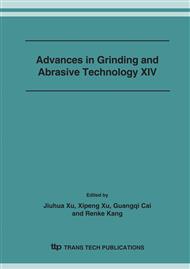p.269
p.274
p.279
p.285
p.290
p.295
p.300
p.305
p.309
Research on the Hydrodynamic Electro-Chemical Mechanical Polishing for Silicon Wafer with Suspension Fluid
Abstract:
Silicon wafer is one of the key materials of LSI and SLSI and has been widely used in the electronic industries and IT products. In the new century of nano times, silicon wafer needs higher geometry accuracy, lower surface roughness and higher precision machining effecency, but no disfigurement in its surface layer. Nowadays, non-contact polishing still seems to be most efficient method to achieve nano-scale geometry accuracy and maintain surface roughness in the nanometer level even for silicon wafer, but it is still not easier to control its machining course and to obtain well-pleasing machining effecency. In this paper, a hydrodynamic electro-chemical polishing system based on CNC is established with micro-displacement compensating for nano-scale polishing. A new type of compliant polishing tool system is developed, which can turn orthogonal force control subspace and position control subspace to isomorphic position servo space. Moreover, it convert force control deflection to position servo deflection and in this way the polishing force is controlled by micro-displacement compensating with piezoelectricity. Polishing experiments on silicon wafer, in hydrodynamic polishing fluid mixed with nano-scale SiO2 abrasive particles, have been conducted to investigate the fundamental machining mechanism.
Info:
Periodical:
Pages:
290-294
Citation:
Online since:
November 2007
Authors:
Price:
Сopyright:
© 2008 Trans Tech Publications Ltd. All Rights Reserved
Share:
Citation:


